By: Sara Kovač / Nova24tv
The campaign Let’s vote of Institute March 8th is clearly not working in favour of their organisers – the leftist lobby. After analysing this year’s situation in the field of voter turnout and support for parties, the connection between the number of respondents who will participate in the elections and supporters of the SDS party can be seen. The higher the turnout, the greater the chance of an even higher advantage for the SDS party over other parties.
The results of the public opinion poll conducted for Nova24TV between April 1st and April 5th, 2022, by the Parsifal agency show that in the period before the elections the number of voters who will vote will increase, while the number decreased for those who will not vote. The next parliamentary elections will certainly be attended by 60.5 percent of respondents. However, only 9.3 percent of respondents would certainly not vote.
In a review over time, the fewest respondents said they would not go to the polls on March 25th, when only 58.3 percent of voters would go to the polls. The number of respondents who would take part in the election increased until April 1st, when as many as 67.7 percent said they would take part in the election.
If we observe the trend of how many voters will take part in the elections and the trend of support for the SDS party, we can see their correlation with each other. This could mean that the higher the turnout, the greater the support for the SDS party. At first, it seemed that higher support was associated with the Gibanje Svoboda party, but the number of their enthusiasts fell rapidly. Apparently, the Let’s vote campaign is not helping its organisers, but will attract even more voters of the connecting parties to the polls.
Of all the respondents, only four parties would cross the parliamentary threshold. Only the SDS party (20.9 percent), Gibanje svoboda party (16.8 percent), SD party (7.9 percent) and Nova Slovenija party (4.5 percent) would get seats in parliament.
Among the decided voters, six parties would cross the parliamentary threshold. Most votes would go to the SDS (28.5 percent), the Gibanje Svoboda (22.9 percent), the SD (10.7 percent), the NSi (6.1 percent), the Levica (5.3 percent) and the Povežimo Slovenijo (5.1 percent). The party Naša dežela lacks extremely few votes for the transfer (3.9 percent), followed by SAB (3.7 percent), LMŠ (2.8 percent), SNS (2.5 percent), DeSUS (2.4 percent), and others.
Janez Janša and his party are leading, ahead of Robert Golob and the Gibanje Svoboda. It is increasingly clear that the formation of the future government will be influenced by smaller parties. According to the latest poll, Janša would be able to form a government, as his potential coalition would receive more votes. People are obviously betting on connectivity, as it is increasingly clear that the Povežimo Slovenijo movement will tip the scales.
Demographic data
The survey included 881 respondents, of which 51.0% were women. The average age is 54.7 years, the standard deviation is 16.3. Most respondents are from the oldest age group (49.5%), the middle age group is slightly less represented (36.5%), and the least respondents are from the youngest age group (14.1%). Most respondents have completed secondary school (32.9%), followed by those with completed higher education (27.8%), 22.6% of respondents have completed vocational school, and 16.7% of respondents have completed primary or incomplete primary school. Most respondents come from a village or hamlet (56.3%), followed by a town (28.7%) and a smaller town (15.0%). Most respondents come from the Osrednjeslovenska region (25.6%), followed by the Podravska (16.2%), and Savinjska (12.7%) regions.

